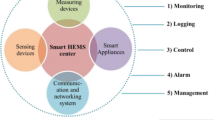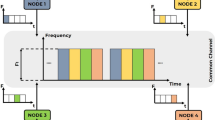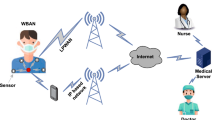Abstract
Disruption tolerant network (DTN) is characterized by frequent partitions and intermittent connectivity. Power management issue in such networks is challenging. Existing power management schemes for wireless networks cannot be directly applied to DTNs because they assume the networks are well-connected. Since the network connectivity opportunities are rare, any power management scheme deployed in DTNs should not worsen the existing network connectivity. In this paper, we design a power management scheme called context-aware power management scheme (CAPM) for DTNs. Our CAPM scheme has an adaptive on period feature that allows it to achieve high delivery ratio and low delivery latency when used with Prophet, a recently proposed DTN routing scheme. Via simulations, we evaluate the performance of the CAPM scheme when used with the Prophet routing scheme in different scenarios e.g. different traffic load, node speeds and sleep patterns. Our evaluation results indicate that the CAPM scheme is very promising in providing energy saving (as high as 80%) without degrading much the data delivery performance.










Similar content being viewed by others
References
Fall K (2003) A delay-tolerant network architecture for chanllenged internets. In: Proceedings of ACM Sigcomm, Karlsruhe, 25–29 August 2003
Burgess J, Gallagher B, Jensen D, Levine BL (2006) Maxprop: routing for vehicle-based disruption-tolerant networks. In: Proceedings of IEEE Infocom, Barcelona, 23–29 April 2006
Jain S, Fall K, Patra R (2004) Routing in a delay tolerant network. In: Proceedings of ACM Sigcomm, Portland, 30 August–3 September 2004
Tariq MMB, Ammar M, Zegura E (2006) Message ferry route design for sparse ad hoc networks with mobile nodes. In: ACM MobiHoc, Florence, 22–25 May 2006
Lindgren A, Doria A, Scheln O (2004) Probabilistic routing in intermittently connected networks. In: Proc. Workshop on Service Assurance with partial and intermittent resources, Fortaleza, 1–6 August 2004
Jun H, Ammar MH, Zegura EW (2005) Power management in delay tolerant networks: a framework and knowledge-based mechanisms. In: Proceedings of IEEE Conference on Sensor and Ad Hoc Communications and Networks (SECON), Santa Clara, 26–29 September 2005
Jun H, Ammar M, Corner M, Zegura E (2006) Hierarchical power management in disruption tolerant networks with traffic-aware optimization. In: ACM Sigcomm Workshop on Challenged Networks (CHANTS), Pisa, 15 September 2006
Armstrong T (2005) Wake-up based power management in multi-hop wireless networks. Term Survey Paper, University of Toronto
Zheng R, Hou JC, Sha L (2003) Asynchronous wakeup for ad hoc networks. In: MobiHoc’03, Annapolis, 1–3 June 2003
Feeney LM, Nilsson M (2001) Investigating the energy consumption of a wireless network interface in an ad hoc network. In: Proceedings of IEEE INFOCOM, Anchorage, 22–26 April 2001
Internet Engineering Task Force (2003) Power Saving in 802.11. http://www1.ietf.org/mail-archive/web/manet/current/msg03227.html
NS (2008) The network simulator ns-2, [Online]. http://www.isi.edu/nsnam/ns/
Tseng Yu, Hsu C, Hsieh T (2002) Power-saving protocols for IEEE 802.11-based multi-hop ad hoc networks. In: Proceedings of IEEE Infocom, New York, 23–27 June 2002
Chen B et al (2001) Span: an energy efficient coordination algorithm for topology maintenance in ad hoc wireless networks. In: Proceedings of 7th ACM, Mobicom, Rome, 16–21 July 2001
Awerbuch B et al (2004) The pulse protocol: energy efficient infrastructure access. In: Proceedings of IEEE Infocom, Hong Kong, 7–11 March 2004
Shih E, Bahl P, Sincalir MJ (2002) Wake on wireless: an event driven energy saving strategy for battery operated devices. In: Proceedings of ACM Mobicom, Atlanta, 23–28 September 2002
Miller MJ, Vaidya NH (2004) Power save mechanisms for multihop wireless networks. In: Proceedings of 1st International Conference on Broadband Networks, San Jose, 25–29 October 2004
Spyropoulos T et al (2006) Performance analysis of mobility-assisted routing. In: Proceedings of ACM Mobihoc, Florence, 22–25 May 2006
Carvalho M, Garcia-Luna-Aceves JJ (2003) Delay analysis of IEEE 802.11 in single-hop networks. In: Proceedings of IEEE ICNP, Atlanta, 4–7 November 2003
Acknowledgements
This work has been supported by DARPA under Contract W15P7T-06-C-P430. Any opinions, findings, and conclusions or recommendations expressed in this paper are those of the authors and do not necessarily reflect the views of the sponsor of this work.
Author information
Authors and Affiliations
Corresponding author
Additional information
Permission to make digital or hard copies of all or part of this work for personal or classroom use is granted without fee provided that copies are not made or distributed for profit or commercial advantage and that copies bear this notice and the full citation on the first page. To copy otherwise, or republish, to post on servers or to redistribute to lists, requires prior specific permission and/or a fee.
Appendix
Appendix
Average taccess:
\(\overline {T_B } \) is the average backoff time, ts is the average time the channel is sensed busy because of a successful transmission.
\(\overline {T_B } \) can be computed as follows:
- q:
-
the success probability that a packet experiences when it is transmitted.
- t c :
-
the average time the channel is sensed busy due to a collision in the channel.
Wmin is the minimum contention window size, and α, β are defined in Eqns (8) and (9).
t s : can be computed as
where τ is the probability that a node transmits in a randomly chosen slot time, H is the packet header transmission time, E{P} is the average packet transmission time. RTS, CTS, SIFS, DIFS, ACK are parameters related to the 802.11 MAC protocol [13].
Equation for computing each variable:
Equations [14],[15], and [16] are used in Eqn [8].
Equations [8]–[11] are used in Eqn [6].
Eqn (17) is used in Eqn (18), and Eqn (18) is used in Eqn (7)
- n :
-
number of nodes
- σ :
-
slot size of the backoff timer
Using the parameter values in Table 4, we obtain taccess and hence obtain θ′ to be approximately 0.3 θ for medium traffic load.
Rights and permissions
About this article
Cite this article
Xi, Y., Chuah, M. & Chang, K. Performance Evaluation of a Power Management Scheme for Disruption Tolerant Network. Mobile Netw Appl 12, 370–380 (2007). https://doi.org/10.1007/s11036-008-0046-4
Received:
Accepted:
Published:
Issue Date:
DOI: https://doi.org/10.1007/s11036-008-0046-4




